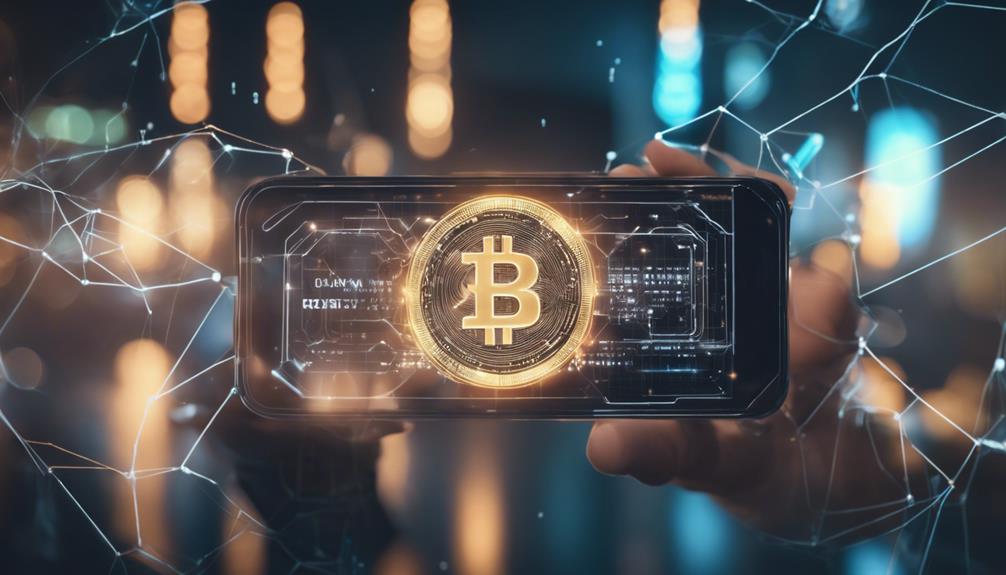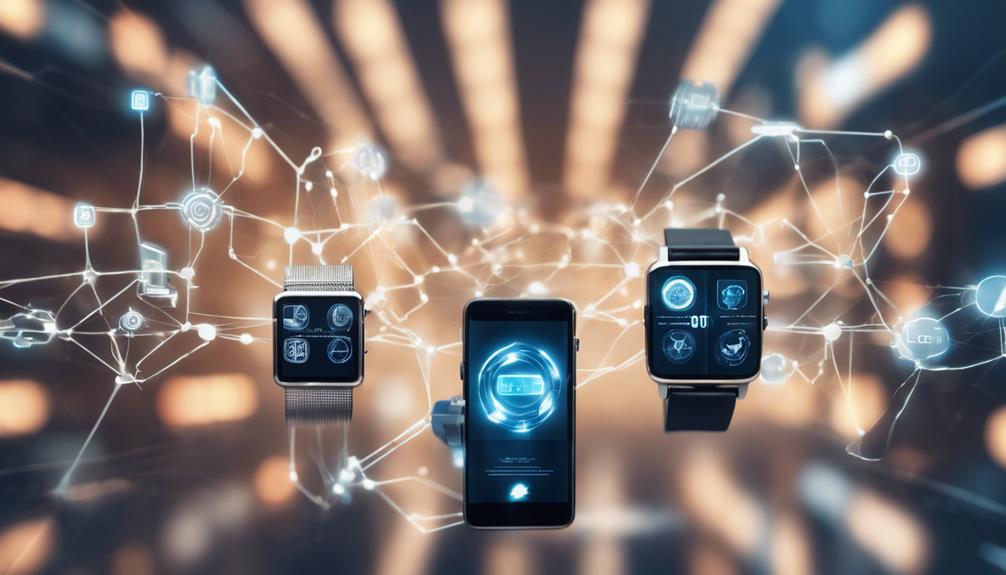Emerging technologies like blockchain, biometrics, AI, and IoT are transforming payment processing. They enhance security, efficiency, and innovation. Blockchain enables secure, borderless transactions while biometrics offer advanced authentication. AI aids in detecting fraud swiftly, and IoT automates transactions for seamless experiences. These innovations shape a future with secure, efficient, and convenient payments. Further exploration beyond this quick answer may reveal deeper insights into the evolving landscape of payment processing.
Key Takeaways
- Blockchain and cryptocurrencies revolutionize security and speed in transactions.
- Contactless payments and NFC technology enhance convenience and drive a cashless society.
- Biometric authentication ensures heightened security and user-friendly processes.
- AI and ML bolster fraud detection by analyzing real-time data and user behavior.
- IoT integration optimizes transaction automation efficiency for seamless payments.
Blockchain and Cryptocurrencies

Blockchain and cryptocurrencies have reshaped the landscape of payment processing by providing a decentralized and secure platform for seamless transactions. Blockchain technology, through its distributed ledger, enhances security in payment processing by reducing the risk of fraud. This innovation allows for borderless transactions, enabling individuals to transfer funds across the globe swiftly. Cryptocurrencies such as Bitcoin and Ethereum play a significant role in this transformation, offering a means for instantaneous value transfers without the need for intermediaries.
Smart contracts, a key feature of blockchain technology, automate payment processes by executing predefined conditions once parties fulfill their obligations. This automation streamlines transactions, particularly beneficial for cross-border payments that would typically involve complex procedures. The integration of blockchain and cryptocurrencies revolutionizes traditional payment systems, paving the way for more efficient, secure, and transparent financial interactions. With automated payment processes and heightened fraud detection, this combination sets a new standard for the future of payment processing.
Contactless Payments and NFC

Contactless payments and NFC technology are transforming the way transactions are conducted, offering a seamless and secure payment experience without physical contact. This advancement in payment processing allows for convenience and speed, making transactions more efficient for consumers and businesses alike. NFC technology facilitates secure communication between devices, guaranteeing that transactions are conducted safely. The adoption of contactless payments has seen a significant increase in recent times, especially post-COVID-19, with many individuals opting to use smartphones, wearables, and smart cards for their transactions. Merchants are also upgrading their payment systems to align with this trend, further promoting a cashless society. The widespread acceptance of contactless payments across various industries reflects a shift towards a more streamlined and effective payment experience for all parties involved. Below is a table highlighting the key aspects of contactless payments and NFC technology:
| Aspect | Description | Examples |
|---|---|---|
| Convenience | Offers ease of transaction without physical contact, saving time for both consumers and businesses | Mobile payments |
| Speed | Facilitates quick and efficient transactions, reducing waiting times | Tap-and-go payments |
| Secure Communication | Guarantees that transactions are conducted safely through encrypted communication | Contactless cards |
Biometric Authentication

Biometric authentication provides heightened security measures and a streamlined transaction experience in payment processing.
By utilizing unique physical characteristics like fingerprints and facial recognition, this technology offers a secure and convenient way to verify transactions without relying on traditional passwords or PINs.
Popular biometric methods such as fingerprint scanning and facial recognition enhance user authentication, ensuring a user-friendly and secure process for accessing financial accounts.
Enhanced Security Measures
Utilizing unique physical characteristics like fingerprints and facial recognition, enhanced security measures in payment processing are achieved through biometric authentication. This method offers secure verification, replacing traditional passwords and PINs with biometric data like fingerprint scanning, facial recognition, and iris scanning.
By incorporating biometric authentication, systems guarantee a user-friendly and convenient experience while maintaining enhanced security levels. This trend in payment processing is crucial for preventing unauthorized access and bolstering the overall security of transactions.
Advancements in biometric technology play a critical role in shaping the future of secure and efficient payment processing systems. Embracing these innovations not only enhances security but also streamlines the authentication process, offering a reliable and robust solution for safeguarding financial transactions.
Streamlined Transaction Experience
As you embrace the streamlined transaction experience facilitated by biometric authentication, the convenience and security of payment processing reach new heights.
Biometric authentication, utilizing unique physical characteristics like fingerprints and facial recognition, offers enhanced security and convenience by replacing traditional passwords and PINs in payment systems. This user-friendly technology guarantees robust security, commonly utilizing fingerprint and facial recognition to accurately authenticate users.
By leveraging individual biological features as secure keys, biometric authentication greatly enhances payment security.
The seamless integration of biometric authentication in payment processes not only streamlines transactions but also provides a heightened level of convenience and strong security, making it an essential component of emerging technologies in secure payment processing.
AI and ML in Fraud Detection

AI and machine learning technologies play a vital role in detecting and preventing fraudulent activities in payment processing. By analyzing real-time data and user behavior, these systems can accurately identify and stop suspicious transactions.
Their adaptive nature enhances the security of payment systems by staying ahead of evolving threats and patterns, ensuring a safer environment for financial transactions.
Fraud Prevention Strategies
To improve security in payment processing, machine learning and artificial intelligence play a fundamental role in detecting and preventing fraudulent activities in real-time. These technologies adapt rapidly to new threats, effectively enhancing fraud prevention measures.
User behavior analysis is employed to accurately identify and prevent fraudulent transactions, ensuring a higher level of security. The AI-driven fraud detection systems in place safeguard the integrity of payment systems by promptly recognizing and halting fraudulent activities.
Embracing the increasing reliance on AI and machine learning is paramount in combating the rising tide of fraudulent transactions within the evolving payment processing landscape.
AI-Driven Risk Analysis
Embracing AI-driven risk analysis revolutionizes fraud detection by harnessing machine learning algorithms to swiftly identify and thwart fraudulent activities in real-time. This approach allows for the adaptation to evolving fraud patterns, enabling more effective prevention strategies.
By utilizing user behavior analysis, AI can accurately pinpoint and prevent fraudulent transactions, enhancing the overall integrity of payment processing. AI-powered systems play a vital role in detecting and mitigating fraud, contributing to the increasing reliance on these technologies to combat the growing instances of fraudulent activities.
This evolution in fraud prevention through AI-driven risk analysis marks a significant advancement in the ongoing battle against financial fraud, providing a proactive and efficient way to safeguard against malicious intent.
IoT and Connected Devices

In the domain of payment processing, the integration of IoT and connected devices revolutionizes transaction automation. This fusion of Internet of Things with payment systems paves the way for efficient transactions and context-aware payments. Here's how this integration is shaping the future of payment processing:
- Autonomous Payments: IoT enables devices like smart refrigerators and cars to autonomously initiate payments, streamlining the transaction process.
- Seamless Integration: Connected devices seamlessly integrate with payment systems, allowing for smooth and context-aware transactions that adapt to the user's needs.
- Future Advancements: The presence of IoT in payment processing signifies a shift towards future technology advancements, where smart devices play a key role in automating transactions efficiently.
This evolution in payment processing not only enhances convenience but also sets the stage for a more interconnected and automated financial ecosystem.
CBDCs Reshaping Economies

As government-issued digital currencies, Central Bank Digital Currencies (CBDCs) are reshaping traditional economies by offering a secure and efficient medium of exchange under direct central bank control. CBDCs, being digital currencies established by governments, represent a notable evolution in the financial landscape.
Countries such as China, Sweden, and the Bahamas have already initiated the exploration of CBDCs, signaling a global trend towards digital currency adoption. One key advantage of CBDCs is the potential to reduce transaction costs substantially, promoting greater financial inclusion by providing easier access to formal financial services.
Additionally, the direct control of central banks over CBDCs can enhance the effectiveness of monetary policies. As CBDCs continue to gain traction, they're expected to revolutionize how transactions are conducted, potentially leading to a more streamlined and secure financial environment in traditional economies.
Data Analytics in Payments

How can data analytics revolutionize payment processing efficiency and security? Data analytics in payments utilizes algorithms and statistical models to extract valuable insights from transaction data. Here's how it can benefit the payment industry:
- Fraud Detection: By analyzing patterns and anomalies in payment activities, data analytics enhances fraud detection capabilities, making transactions more secure for both businesses and consumers.
- Personalized Customer Experiences: Through analyzing spending behavior and preferences, data analytics enables businesses to provide personalized experiences to customers, improving customer satisfaction and loyalty.
- Risk Management: Data analytics plays a critical role in risk management by identifying potential fraudulent activities and ensuring transaction security. By leveraging machine learning techniques, financial institutions can make more informed decisions, ultimately enhancing the overall security of payment transactions.
Incorporating data analytics into payment processing not only boosts efficiency but also heightens security measures, leading to a more seamless and secure payment experience for all parties involved.
Mobile Commerce Expansion

Embrace the exponential growth of mobile commerce expansion, propelling businesses into the forefront of digital sales. With mobile commerce projected to reach $3.56 trillion in global sales by 2021, it's evident that this platform is reshaping the way consumers interact in the digital marketplace. Over 70% of smartphone users have embraced mobile commerce, making purchases with an average order value of $85, showcasing the substantial revenue potential for businesses. The high conversion rates of mobile commerce apps compared to websites emphasize the importance of providing a seamless mobile shopping experience to customers.
Moreover, the integration of augmented reality (AR) and virtual reality (VR) technologies is revolutionizing the mobile commerce landscape, enhancing user engagement and driving further growth in this sector. As businesses adapt to these technological advancements, they're better positioned to capitalize on the opportunities presented by the expanding mobile commerce environment, offering customers a more immersive and interactive shopping experience.
Cross-Border Transactions Focus

When it comes to cross-border transactions, you'll face challenges with currency exchange rates, making it important to take into account the impact on your payments.
Maneuvering regulatory compliance requirements can be complex, but staying informed is essential to guarantee smooth international transactions.
Exploring blockchain technology for security measures can provide a reliable solution for safeguarding your cross-border payments.
Currency Exchange Challenges
Managing currency exchange challenges in cross-border transactions demands a keen understanding of the fluctuating exchange rates and hidden fees impacting transaction costs. When dealing with international payments, consider the following:
- Fluctuating Exchange Rates: Keep track of the dynamic nature of exchange rates to make informed decisions.
- Hidden Fees: Be wary of additional charges imposed by financial institutions that may inflate the overall cost.
- Markup Rates: Understand the markup rates applied to currency exchange transactions to assess the true value.
Blockchain technology and fintech solutions, such as peer-to-peer currency exchange platforms, are emerging as viable alternatives to traditional methods, offering transparency and competitive rates in cross-border transactions.
Regulatory Compliance Complexities
Traversing the intricate web of regulatory compliance in cross-border transactions poses significant challenges for both fintech companies and traditional financial institutions. The complexities stem from differing AML regulations, KYC policies, and data privacy laws across various jurisdictions.
Additionally, ensuring compliance with measures like GDPR further complicates the landscape of cross-border payment processing. Fintech companies and financial institutions must grapple with regulatory frameworks such as PSD2 to facilitate seamless transactions while meeting stringent regulatory requirements.
Harmonizing these regulations globally is essential for efficient and lawful cross-border payment operations. Tackling the maze of regulatory compliance demands a meticulous approach to uphold the integrity and security of cross-border transactions in an ever-evolving regulatory environment.
Blockchain for Security
Considering the increasing need for enhanced security in cross-border transactions, blockchain technology emerges as a pivotal solution. When it comes to utilizing blockchain for security in cross-border transactions, here are three key advantages:
- Decentralized Ledger: Blockchain technology provides a decentralized ledger system, ensuring transparency and security in cross-border transactions.
- Reduced Costs: Integrating blockchain in payment processing reduces costs associated with international transfers, benefiting both businesses and consumers.
- Faster Transaction Times: Blockchain enables faster transaction times compared to traditional methods, making cross-border payments more efficient and timely.
With its immutable ledger and increased security measures, blockchain is reshaping the landscape of global commerce, offering a reliable and efficient solution for cross-border transactions.
Collaboration for Payment Innovation

Amidst the rapidly evolving landscape of payment processing, fostering collaborative partnerships between fintech innovators and traditional banking institutions is propelling the industry towards innovative solutions. By combining the strengths of both sectors, these collaborations aim to create user-friendly and secure payment solutions that enhance customer experiences. The shared expertise between fintech companies and traditional banks enables the development of cutting-edge technologies, ensuring seamless transactions and the integration of emerging payment channels.
Through joint efforts, a synergy is established that not only prioritizes security but also focuses on efficiency, streamlining payment systems for the benefit of all stakeholders. This collaborative approach paves the way for the continuous evolution of payment processing, adapting to the changing needs of consumers and businesses alike. By working together, fintech firms and traditional banks can leverage their respective strengths to drive innovation, ultimately shaping the future of payment processing towards more convenient, secure, and efficient solutions.
Frequently Asked Questions
What Is the Future of Payments Technology?
In the future, payments technology will evolve to be more essential, seamless, and automated. Advancements in blockchain, AI, and IoT drive this progress.
Contactless payments and biometric authentication enhance convenience and security, transforming the payment landscape.
Subscription-based payments and digital wallets are reshaping consumer interactions with financial transactions.
Collaboration between fintech firms, banks, and regulators is vital for developing innovative payment solutions.
Real-time transactions, IoT-enabled autonomous payments, and Payment-as-a-Service models are key components of the future payment ecosystem.
Which Is a Technology That Can Be Used for Payment Processing?
Blockchain technology is an essential player in modern payment processing. Its secure and transparent ledger system offers reliability. Cryptocurrencies like Bitcoin and Ethereum utilize blockchain for borderless transactions.
Contactless payment methods, such as NFC, allow quick and convenient transactions. Biometric authentication, like fingerprint and facial recognition, enhances security.
AI and machine learning are vital for real-time fraud detection, ensuring safer transactions. These technologies shape the future of payment processing.
What Is the Strongest Current Trend in Payment Processing?
The strongest current trend in payment processing is the increasing popularity of contactless payments through smartphones and wearables. This surge follows the post-COVID-19 era, where convenience and speed are paramount.
Mobile wallets like Apple Pay and Google Pay are on the rise, offering seamless transactions. Biometric authentication methods such as fingerprint and facial recognition are enhancing security measures.
This trend reflects a shift towards more efficient and secure payment methods in today's digital landscape.
What Is the Next Generation Payment Technology?
Next generation payment technology is constantly evolving to offer you more secure and efficient ways to make transactions. One example is biometric authentication, which enhances security measures.
Technologies like blockchain and cryptocurrencies are also making waves in reshaping payment processing. Contactless payments and NFC technology are becoming mainstream, providing convenience and speed.
Artificial Intelligence and machine learning play an essential role in real-time fraud detection. Subscription-based models are gaining popularity, offering automated billing and better customer experiences.
Conclusion
As you navigate the ever-evolving landscape of payment processing, remember that staying informed about emerging technologies is key to success.
Just like a skilled pianist must constantly practice to master new melodies, businesses must adapt to the changing rhythms of the payment industry.
Embrace these advancements like a conductor leading a symphony, orchestrating seamless transactions for your customers.
With the right tools and knowledge, you can harmonize your payment processing strategies for a melodious future.










